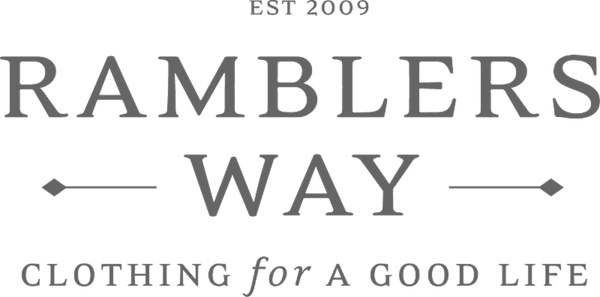OUR COMPANY
Wool Clothing with Purpose, Made in the USA
Ramblers Way began with a simple but powerful question:
What if the clothes we wear every day could be made better: for people, for place, and for the planet?
That question first sparked in 2008, when our founder Tom Chappell (yes, the same Tom behind Tom’s of Maine) was hiking through the sheep-dotted hills of Wales. Despite trying a range of high-performance gear, Tom couldn’t find a single shirt that kept him warm, dry, and fresh from the trail to the inn. He admired how the sheep around him seemed perfectly comfortable, no matter the weather. The answer, he realized, was right in front of him.

When he returned home to Maine, Tom set out to create the ultimate base layer: a next-to-skin shirt made of wool, soft, moisture-wicking, odor-resistant, and proudly American-made. That idea became Ramblers Way.
A New Generation, A Shared Vision
In 2025, we, David and Stacey Weinstein, a husband-and-wife team raising our family in New England, stepped in to carry the brand forward. Inspired by the region’s textile heritage and grounded in values like craftsmanship, community, and responsibility, we are guiding Ramblers Way into its next chapter.

We’ve simplified our focus to what we do best:
Wool essentials made for everyday comfort and long-term wear.
That means breathable, next-to-skin layers like tees, long johns, tanks, and leggings built to last, not just to sell.
Why Wool? Why Here?
Wool is one of nature’s most remarkable fibers. It insulates, breathes, wicks moisture, and resists odor all without synthetic chemicals. It’s renewable, biodegradable, and surprisingly easy to care for. And when we make it here in the U.S., we ensure not only quality, but accountability every step of the way.

At Ramblers Way, we don’t chase trends. We build timeless, functional garments that reflect our values and yours.
What We Believe
We’re guided by four simple principles:
Do what you say you’re going to do.
Make things the right way.
Be a dependably good company.
Act for tomorrow today.
Whether you're layering up for a hike, heading to work, or staying cozy at home, Ramblers Way offers pieces you can feel good about in every sense.
We’re proud to be part of a growing movement that values quality over quantity, tradition over trends, and people over profit.
Thanks for rambling along with us. The journey is just beginning.
